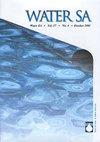Alternative streamflow-based approach to estimate catchment response time in medium to large catchments: case study in Primary Drainage Region X, South Africa
IF 1
4区 环境科学与生态学
Q4 WATER RESOURCES
引用次数: 0
Abstract
Event-based estimates of the design flood in ungauged catchments are normally based on a single catchment response time parameter expressed as either the time of concentration (TC), lag time (TL) and/or time to peak (TP). In small, gauged catchments, a simplified convolution process between a single observed hyetograph and hydrograph is generally used to estimate these time parameters. In medium to large heterogeneous, gauged catchments, such a simplification is neither practical nor applicable, given that the variable antecedent soil moisture status resulting from previous rainfall events and spatially non-uniform rainfall hyetographs can result in multi-peaked hydrographs. In ungauged catchments, time parameters are estimated using either empirical or hydraulic methods. In South Africa (SA), unfortunately, the majority of the empirical methods recommended for general use were developed and verified in catchments ≤ 0.45 km² without using any local data. This paper presents the further development and verification of the streamflow-based approach developed by Gericke (2016) to estimate observed TP values and to derive a regional empirical TP equation in Primary Drainage Region X, SA. A semi-automated hydrograph analysis tool was developed to extract and analyse complete hydrographs for time parameter estimation using primary streamflow data from 51 flow-gauging sites. The observed TP values were estimated using three methods: (i) duration of total net rise of a multi-peaked hydrograph, (ii) triangular-shaped direct runoff hydrograph approximations, and (iii) linear catchment response functions. The combined use of these methods incorporated the high variability of event-based time parameters, and Method (iii), in conjunction with an ensemble-event approach sampled from the time parameter distributions, should replace the event-based approaches to enable the improved calibration of empirical time parameter equations. The conceptual approach used to derive the regional empirical TP equation should also be adopted when regional equations need to be derived at a national scale in SA.估算大中型集水区集水响应时间的基于流体流量的替代方法:南非 X 主要排水区的案例研究
在无测量集水区,基于事件的设计洪水估算通常基于单一的集水区响应时间参数,该参数可表示为集中时间 (TC)、滞后时间 (TL) 和/或达到峰值的时间 (TP)。在小型测量集水区,通常使用单一观测水位计和水文图之间的简化卷积过程来估算这些时间参数。在大中型异质性测量集水区,这种简化方法既不实际也不适用,因为以前的降雨事件和空间不均匀的降雨水位图会导致多峰水文图,从而造成土壤水分状况的多变。在无测站流域,时间参数的估算可采用经验法或水力法。遗憾的是,在南非(SA),大多数推荐普遍使用的经验方法都是在面积小于 0.45 平方公里的集水区开发和验证的,没有使用任何当地数据。本文介绍了对 Gericke(2016 年)开发的基于水流的方法的进一步开发和验证,该方法用于估算观测到的 TP 值,并推导出南澳大利亚 X 一级排水区的区域经验 TP 方程。开发了一种半自动水文图分析工具,利用 51 个测流点的原始水流数据提取和分析完整的水文图,用于时间参数估计。观测到的 TP 值使用三种方法进行估算:(i) 多峰水文图总净上升持续时间;(ii) 三角形直接径流水文图近似值;(iii) 线性流域响应函数。这些方法的综合使用结合了基于事件的时间参数的高变异性,方法(iii)与从时间参数分布中采样的集合事件方法相结合,应能取代基于事件的方法,从而改进经验时间参数方程的校准。当需要在南澳大利亚全国范围内推导区域经验时间参数方程时,也应采用推导区域经验 时间参数方程的概念方法。
本文章由计算机程序翻译,如有差异,请以英文原文为准。
求助全文
约1分钟内获得全文
求助全文
来源期刊

Water SA
环境科学-水资源
CiteScore
2.80
自引率
6.70%
发文量
46
审稿时长
18-36 weeks
期刊介绍:
WaterSA publishes refereed, original work in all branches of water science, technology and engineering. This includes water resources development; the hydrological cycle; surface hydrology; geohydrology and hydrometeorology; limnology; salinisation; treatment and management of municipal and industrial water and wastewater; treatment and disposal of sewage sludge; environmental pollution control; water quality and treatment; aquaculture in terms of its impact on the water resource; agricultural water science; etc.
Water SA is the WRC’s accredited scientific journal which contains original research articles and review articles on all aspects of water science, technology, engineering and policy. Water SA has been in publication since 1975 and includes articles from both local and international authors. The journal is issued quarterly (4 editions per year).
 求助内容:
求助内容: 应助结果提醒方式:
应助结果提醒方式:


